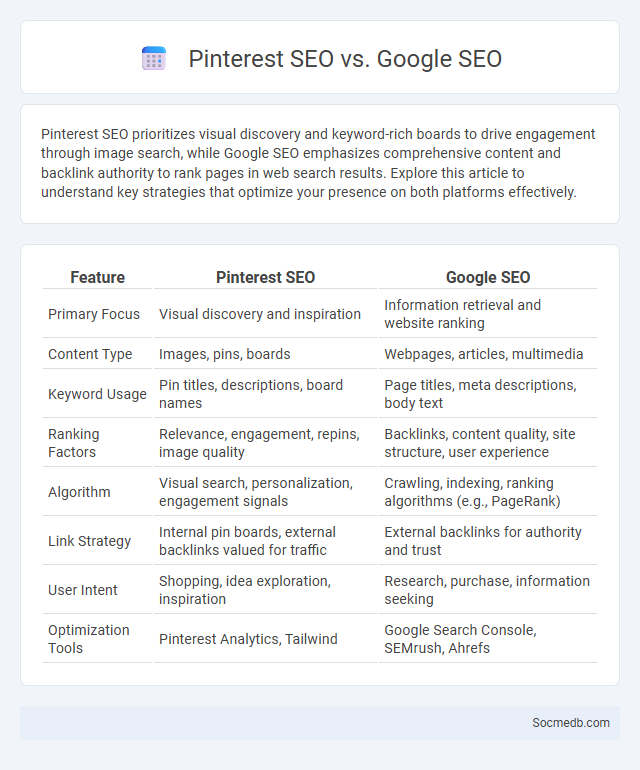
Photo illustration: Pinterest SEO vs Google SEO
Pinterest SEO prioritizes visual discovery and keyword-rich boards to drive engagement through image search, while Google SEO emphasizes comprehensive content and backlink authority to rank pages in web search results. Explore this article to understand key strategies that optimize your presence on both platforms effectively.
Table of Comparison
| Feature | Pinterest SEO | Google SEO |
|---|---|---|
| Primary Focus | Visual discovery and inspiration | Information retrieval and website ranking |
| Content Type | Images, pins, boards | Webpages, articles, multimedia |
| Keyword Usage | Pin titles, descriptions, board names | Page titles, meta descriptions, body text |
| Ranking Factors | Relevance, engagement, repins, image quality | Backlinks, content quality, site structure, user experience |
| Algorithm | Visual search, personalization, engagement signals | Crawling, indexing, ranking algorithms (e.g., PageRank) |
| Link Strategy | Internal pin boards, external backlinks valued for traffic | External backlinks for authority and trust |
| User Intent | Shopping, idea exploration, inspiration | Research, purchase, information seeking |
| Optimization Tools | Pinterest Analytics, Tailwind | Google Search Console, SEMrush, Ahrefs |
Introduction to Pinterest SEO vs Google SEO
Pinterest SEO emphasizes visual search optimization, relying heavily on image quality, keyword-rich pin descriptions, and board organization to increase visibility within the platform's discovery algorithm. Google SEO prioritizes website content relevance, keyword usage, backlinks, and site authority to rank pages in search engine results pages (SERPs). While Pinterest drives traffic through visual and thematic curation, Google SEO targets informational intent with comprehensive content optimization across diverse web formats.
Understanding Search Intent in SEO Strategies
Understanding search intent is crucial for optimizing your SEO strategies, as it aligns content with what users are genuinely seeking on social media platforms. Accurately identifying whether your audience's intent is informational, navigational, transactional, or commercial investigation enhances content relevance and engagement. You can significantly boost your social media visibility and user interaction by tailoring posts and keywords to match these specific search intents.
Key Differences Between Pinterest SEO and Google SEO
Pinterest SEO focuses on visual content optimization, leveraging rich pins, keywords in image descriptions, and engaging visual signals to rank within the platform's search results. Google SEO emphasizes comprehensive website optimization, including keyword research, meta tags, backlinks, and technical site structure to improve rankings on the broader search engine results pages (SERPs). Unlike Google, Pinterest acts as a visual discovery engine where user engagement and pin quality heavily influence visibility and organic reach.
How Search Intent Shapes Content Discovery
Search intent significantly shapes how users discover content on social media platforms by tailoring algorithms to prioritize posts that match user queries and behavior patterns. Platforms like Instagram, Facebook, and Twitter use intent-driven data signals such as keywords, hashtags, and user interactions to serve relevant content in feeds and search results. Understanding search intent helps marketers create targeted content that aligns with audience needs, boosting visibility and engagement in social media environments.
Algorithm Comparison: Pinterest vs Google
Pinterest's algorithm prioritizes visual discovery by emphasizing user engagement signals such as clicks, saves, and close-up views, optimizing content based on personalized interests and search queries. Google's algorithm leverages advanced natural language processing and semantic search techniques to deliver highly relevant results by analyzing intent, context, and content authority across billions of indexed pages. While Pinterest focuses on image-centric content curation for inspiration, Google excels at comprehensive information retrieval through a broad and dynamic ranking system.
Keyword Optimization Techniques for Each Platform
Effective keyword optimization techniques vary by social media platform, leveraging unique algorithms and user behaviors to maximize reach. On Instagram, incorporating targeted hashtags with a blend of popular and niche keywords enhances content discoverability, while Facebook benefits from natural keyword integration in posts and group descriptions to align with search queries. Twitter requires concise and trending keyword usage within tweets and bio, optimizing for real-time engagement and hashtag searchability on this fast-paced platform.
Visual vs Text-Based Search: Impact on SEO
Visual search technologies enable users to upload images to find related content, significantly enhancing SEO by targeting image recognition algorithms and optimizing visual metadata such as alt tags and file names. Text-based search relies on keywords, phrases, and natural language processing, making keyword research and content optimization crucial for improving your search engine ranking. Integrating both visual and text search strategies boosts your social media presence by capturing diverse user intents and increasing engagement across varied search methods.
User Behavior and Engagement Metrics Analysis
User behavior on social media platforms is analyzed through engagement metrics such as likes, shares, comments, and click-through rates, providing insights into content resonance and audience preferences. Advanced analytics tools track session duration, bounce rates, and conversion paths to optimize user experience and tailor marketing strategies. Understanding these patterns enables brands to increase interaction, boost retention, and enhance overall platform effectiveness.
Tips for Aligning Content with Search Intent
Understanding search intent types--informational, navigational, and transactional--enables content creators to tailor social media posts that precisely address user needs. Crafting captions and hashtags that include relevant keywords boosts visibility and engagement by matching what users actively search for. Leveraging analytics to monitor audience behavior helps refine content strategy, ensuring posts align with evolving search queries and drive targeted traffic.
Choosing the Best SEO Approach for Your Goals
Choosing the best SEO approach for your goals requires understanding your target audience and industry-specific keywords. You should analyze competitors' strategies and prioritize high-impact keywords that align with your content on social media platforms. Optimizing profiles, creating engaging posts, and using relevant hashtags enhance visibility and drive organic traffic to your brand.
 socmedb.com
socmedb.com